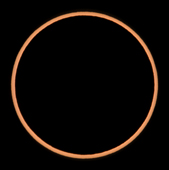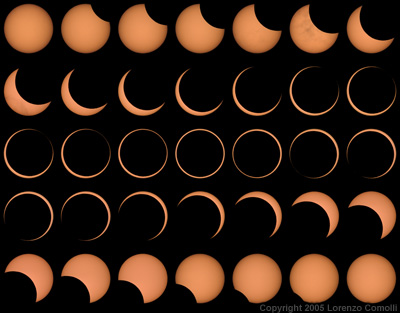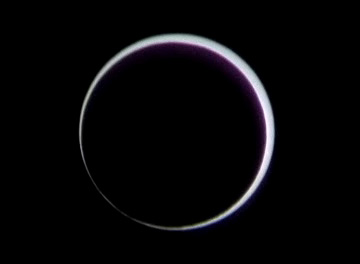
The images of October 3, 2005
Annular Solar Eclipse,
by Lorenzo Comolli

 |
The images of October 3, 2005
Annular Solar Eclipse, |
 |
Spain
2005
Cumbre
del Sol - Cabo de la Nao (100km SE of Valencia)
38°43'09.7" N 0°09'34.0" E 430m
heigth
This are some of the images of the
October 3, 2005 Annular Solar Eclipse, from the skys of Spain.
 |
I've
collected all the images of the ecipse in a picture that show the
evolution of the complete eclipse. For the hires image, click on the image at left. |
 |
The
animation of the complete eclipse, click on the image at left (GIF
animation 2Mb) Number of images in the animation: 39 |
 II contact  III contact |
Movies of
the eclipse obtained with a MiniDV digital videocamera Panasonic
NV-DS15, with an optical multiplier, obtaining an optical zoom of 60x.
Solar filter in Astrosolar D=5 (and so the Sun is white). In the two movies at left (click for the AVI movies of 300kb, DivX 5.2 compression) are recorded the initial and final phases of the annularity. |
 |
For other
landscape images, click on the image at left. Number of images: 11 |
Please feel free to write me for every comment: comolli@libero.it.
Actors: Lorenzo Comolli, Alessandro Gambaro, Alberto Gianni, Marco Scardia, Emmanuele Sordini and many other amatour astronomers from all over the Europe. All the hours are in central Europe summer time (TU+2).
h 23.00 of the day before:
we go to sleep after a dinner based on typical "paella valenciana", we
have a look at the sky and it's clear, we see the Milky Way!!! Good!
h 6.00: we wake up and open
the window, and... NOOOO, completely cloudy!!! But we don't discourage
and we prepare quickly.
h 7.00: after a short trip,
we are on the observing location, named Cumbre del Sol, a hill that
overlook the Mediterranean Sea. There is a wonderful view of the Cabo
de la Nao. Unfortunately the sky is covered, but some holes in the
clouds give us some hope. We start to assemble our instruments, and I
need a lot of time because I've divided my instruments in a lot of very
small parts for putting inside the suitcase...
h 8.00: the Sun rise in the
clouds, but a hole show us some light rays. We continue to assemble the
instrumend and hope.
h 9.00: the Sun is still
covered by the clouds that have a strange behaviour: the arrive from
North, pass on the Sun and then disapper completely. A couple of
kilometers at South the sky is clear and the landscape is illuminated
by the Sun. This is a crucial moment: we consult to decide to stay or
go away, to search a better place with the Sun. After a difficult
discussion, we decide to stay here, because the trend is an opening.
h 9.30: finally we see the
Sun and start to take the first photos, with the Sun out of the eclipse.
h 9.42: first contact, but
unfortunately a cloud cover the Sun and we miss the moment.
h 9.54: the clouds finally
go away amd we can experimentally verify that the eclipse is really
started!
h 10.00: the last clouds
pass over the Sun. From this moment, no other clouds will bother us!
Wow!
h 10.30: Alessandro show us
his map of Spain, all the amatour astronomers in the field come to see.
Why? Maybe we are in a wrong place? NO!!! The map is full of holes and
project on the wall behind the map a lot of small Sun images. All the
holes make the phrase "Spain 3-10-05". We shot tens of images, so we
will surely remember where and when we was...
h11.00: second contact, this
is the topical moment: all the photo cameras shot a lot of images and
it's wonderful to observe the lunar mountains that gradually cover the
Sun and show us many Baily beads. Finally we are happy because the
clouds don't interfered in the success of the expedition! Well done!
h 11.02: we are at the
maximum eclipse, the show is superb, with a perfect ring drawn in the
sky. Marco read the temperature, 13.6°C, less than half a degree
Celsius under the temperature out of the eclipse, 14.0°C. A very
small decrease that we'll try to explain later. Alessandro raise the
hand to the sky, but not for thanks for the show! He noticed that the
shadow of his hands is very strange, and the annular Sun project double
images of the hands!
h 11.04: third contact, the
time run in the wink of an eye, but the show has still to come. The
exit of the Moon is even more interesting because a hige Lunar valley
leave a small part of Sun between the black sky. The Baily beads produced by
the Lunar mountains are visible for another minute, expecially with a
binocular.
h11.30: the eclipse go on
but the time seems to be stopped. The principal phase gone awau and we
relax chatting with the other amatours on the hill, they come from all
Europe: France, Belgium, Germany, Austria...
h 12.30: fourth contact, the
eclipse is finished! We discuss of the eclipse and all are extremely
happy for the morting, even more considering the thich clouds when the
Sun rose! Some of us have observer a total solar eclipse and we agree
that the "taste" of an anular is something deeply different from a
total, something for "connoisseurs", surely less exciting but that
cannot lack in a curriculum of an amatour astronomer.
Link to the pages of the other friends:
|
|